From the high altitude peaks of the Simien Mountains, to the scorching heat of the Danakil depression, one of the defining features of rural Ethiopia are the farmers and livestock herders who make a living in some of the most diverse and extreme environments in Africa.
Ethiopia has a history of cultivated agriculture and pastoralism that dates back thousands of years. It is home to the largest number of livestock on the continent and also lays claim to a unique cuisine based around the fermentation of the indigenous cultivar ‘teff’.
Not to mention its iconic global export: coffee. Which Ethiopians prepare with an enchanting customary ritual.
In many ways, food production is the glue that holds together Ethiopia’s myriad cultures and landscapes. However, big changes are beginning to dramatically transform rural Ethiopia and catapult it into the global economy.
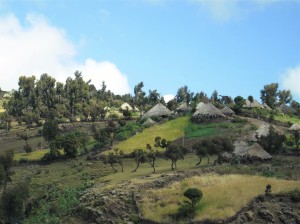
Village in Simien Mountains National Park, Amhara
Agri-food sector reforms are well underway
The Federal Government of Ethiopia is leading the charge. It wants to boost agri-food exports to help fund its ambitious social and economic development agenda.
It has grand plans to modernise the country’s smallholder farming systems and increase private sector investment while simultaneously reducing food insecurity and vulnerability to climate change.
In 2008 the country launched Africa’s first commodity exchange, the ECX. Its electronic signs and mobile phone services provide farmers with real time information on prices and a secure payment system to guarantee cash on delivery.
The donor-funded Agricultural Transformation Agency has a mandate overcome barriers to productivity growth. With the help of a revolving door of fresh-faced international strategy consultants they have initiated the production of tailor-made fertilizers for Ethiopian soils, as well as piloting ‘clusters’ of commodity-focused farmer cooperatives and rolling out new technologies and services for farmers.
Meanwhile Chinese contractors are constructing road networks and an electrified railway line to connect the interior with the Port of Djibouti. And investors are lining up to take advantage of the potentially lucrative export markets and burgeoning domestic demand for fresh and processed food products.
These developments would appear to hold much promise for a country whose modern image has been unfairly tarnished by a 1980s famine that belies its people’s agricultural ingenuity.
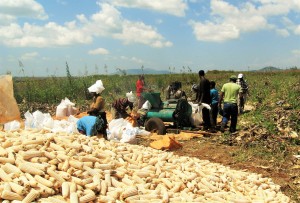
Harvested maize being processed for market near Nekemte, Oromia
Many challenges must be overcome for Ethiopia to successfully establish a sustainable agri-food system
One critical constraint is to sustain the productive capacity of agricultural landscapes in Ethiopia.
In many areas agricultural landscapes have been exhausted by the progressive intensification of cultivated agriculture, as well as the continued reliance on fuelwood and open-grazing practices that incrementally reduce vegetation and perennial grass cover.
The consequence has been widespread soil erosion and land degradation. The Guraghe region south-west of the capital Addis Ababa is a telling example where massive erosion channels are a major threat to productive land and local infrastructure, such as roads and schools (see photo below).
Local researchers and conservation organisations have also cautioned that on-going soil erosion from agriculture threatens to significantly reduce the lifespan of the country’s hydroelectric dams in the Omo-Gibe river basin through siltation.
In short, this means that any productivity gains made through the increased use of fertilisers and new technologies could be short-lived if soil and earth continues to wash away causing negative externalities.
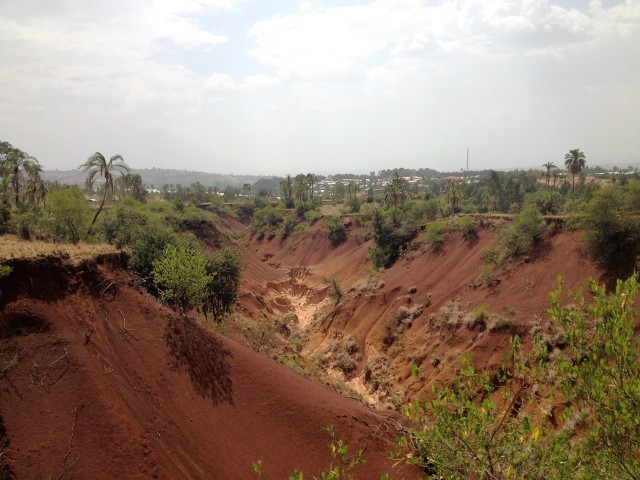
Erosion in Guraghe region near Wolkite, SNNP
However, Ethiopian farmers are not standing idly by watching their agricultural lands degrade. There are countless examples across the country of impressive efforts by farming communities to reduce erosion and rehabilitate their degraded agricultural landscapes. Examples include the infamous FMNR project in Humbo and regreening initiatives in Tigray.
In addition, local and international researchers are collaborating on advanced agroforestry techniques that promise to deliver both environmental benefits and productivity gains for smallholder farmers.
The problem is that erosion control infrastructure like check-dams are often poorly maintained and thus the environmental benefits are not sustained. Moreover, smallholder farmers, who are usually living close to the poverty line, favour farming techniques that provide a shorter-term return on investment, such as planting small woodlots of fast-growing eucalyptus trees, rather than more complex agroforestry systems that deliver long-term benefits.
This raises some important questions about what the role of conservation agriculture should be within Ethiopia’s desired shift towards an export-orientated agri-food sector.
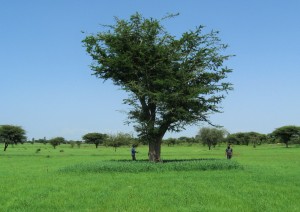
Tree-cropping system research trial in the Rift Valley near Mojo, Oromia
Another critical issue is conflict between traditional and modern land-use practices.
For example, the expansion of irrigated cotton and sugar plantations in the Awash valley has cut off some pastoral communities from their traditional grazing lands.
While in other parts of Oromia, foreign-owned agribusinesses have been targeted by protestors who perceived them as encroaching on the traditional rights of local smallholder farmers.
This creates a challenge for any investors wanting to establish a social license to operate in areas where clearly defined land rights have not been the norm or customary land rights have been overridden. Particularly given the Federal Government of Ethiopia is already facing domestic opposition to its expansive reform agenda.
Many of these issues are not unique to Ethiopia. Globally, there is need to improve the sustainability of agricultural production systems in the face of climate change and environmental degradation. There is also a corresponding increase in consumer demand for agribusinesses to prove their social and environmental credentials.

Pastoral communities discuss land-use issues near Awash National Park, Oromia
There is an opportunity for Ethiopia to forge its own model of sustainable agriculture
This model could build upon its history of agricultural ingenuity and unique blend of cultures and landscapes.
For example, some smallholder farmers could to be given the right incentives to adopt agricultural practices that deliver long-term environmental benefits, such as agroforestry techniques that integrate food production for local markets with the delivery of ecosystems services that provide landscape and catchment-scale benefits.
These farmers could play an instrumental role in sustaining the productive capacity of farming landscapes that are dedicated to commodity production through the provision of important ecosystem services, such as erosion control and moisture retention. Moreover, they could be strategically located along riparian buffer zones to help to reduce sediment loads entering rivers in order to maintain the expected lifespan of hydroelectric energy infrastructure (i.e. through land-use planning and/or integrated catchment management systems).
This would align well with the recommendations of the International Panel of Experts on Sustainable Food Systems, which signals the need for a global shift towards diversified agro-ecological farming systems.
In addition, as a recently retired Ethiopian agroforestry expert once implored to me, there is a need to build a social and cultural movement to rehydrate the country’s landscapes.
Such a movement could involve mutually beneficial business partnerships between smallholder farmers, pastoralists, and agribusinesses. These partnerships could be formed on the basis of protecting and enhancing the productive capacity of the natural resource base upon which both traditional and modern farming systems depend.
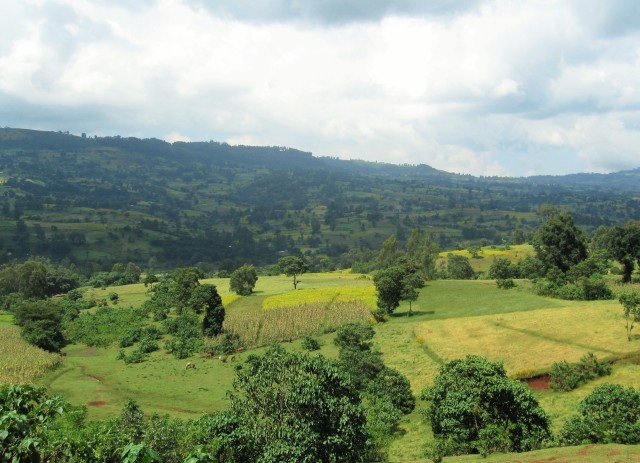
An example of a diverse landscape in Ethiopia
Conclusion
To date the focus of the agri-food sector transformation agenda in Ethiopia has been on the transfer and diffusion of modern agricultural technologies, infrastructure and practices.
Yet Ethiopia would likely benefit more if it also considered how it can capitalise on its long history of small holder agriculture and pastoralism, and seek to establish diversified farming systems that combine food and fibre production with the provision of ecosystem services.
But perhaps most importantly, the agri-food systems being established in Ethiopia must remain in harmony with the country’s diverse cultures and landscapes. For food production is as much as cultural activity as it is an economic development activity and local people and communities must benefit from and be a partner in any agri-food system reforms.
This could be the key to unlocking a unique sustainable development pathway in Ethiopia that meets the country’s socio-economic development ambitions while preserving important aspects of its unique cultures and landscapes.
